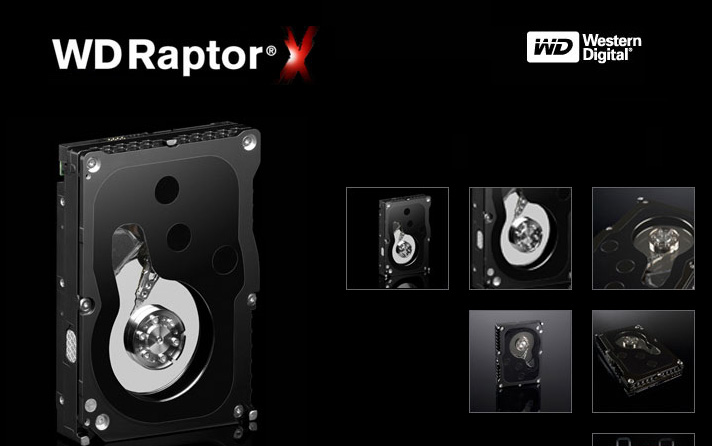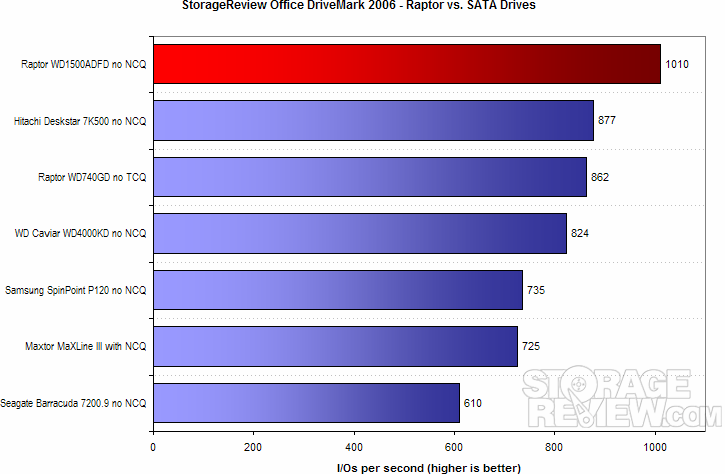WDís long-awaited update to the 10,000 RPM SATA Raptor has arrived! The familyís new bellwether ups capacity up to 150 gigabytes and claims to significantly increase performance while maintaining the lineís admirable power and noise levels. Join StorageReview as we pit the Raptor WD1500 up against every currently available SCSI and SATA flagship.
To review: http://www.storagereview.com/articles/200601/WD1500ADFD_1.html
Performance Specifications
Rotational Speed 10,000 RPM (nominal)
Buffer Size 16 MB
Average Latency 2.99 ms (nominal)
Contact Start/Stop Cycles 20,000 minimum
Seek Times
Read Seek Time 4.6 ms
Write Seek Time 5.2 ms (average)
Track-To-Track Seek Time 0.4 ms (average)
Full Stroke Seek 10.2 ms (average)
Transfer Rates
Buffer To Host (Serial ATA) 1.5 Gb/s (Max)
Buffer To Disk 72 MB/s (Sustained
+ Reply to Thread
Results 1 to 24 of 24
-
-
Surprised its not SATA II (3 Gb/s max)Buffer To Host (Serial ATA) 1.5 Gb/s (Max)
-
-
That is probably something that a firmware update will fix. Most drives do not automatically come with SATA II specs. I have had to flash many drives to gain SATA II speeds.Originally Posted by waheedBelieving yourself to be secure only takes one cracker to dispel your belief.
-
Quite expensive. Checked the prices here in the UK, its retailing over £200. Thats twice the cost I paid for the WD 74GB Raptor.
-
72 MB/s sustained is too little for 4:2:2 SDI (or 720x480 4:2:2 uncompressed) and way more than needed for Huffyuv, DV, HDV or HDTV-MPeg2_TS, so what's the video application for such a drive vs a typical 50MB/s PATA or SATA drive?
Recommends: Kiva.org - Loans that change lives.
http://www.kiva.org/about -
I would have thought you'd eat all the bandwidth it has to offer up if you are doing real-time video editing in After Effects or something. However, can a drive actually saturate a 300Mbps connection? I didn't think they could physically work that fast.
-
We cannot back up much on 150Gig at 270 MB/sec if it were possible anyway. I'd say it would be useful inline with real time converters to compress high end video to 50 MB/sec and 25 MB/sec. You can upsample later if needed.Originally Posted by edDV
-
or if nothing else, it would make for a heck of a drive to boot up your OS with (though kinda small by today's standards)
-
Nah, that's nothing compared to this:
http://www.hyperossystems.co.uk/
(Look at that RAM drive! Whoooaaaa!) -
Max capacity, only 16 GBOriginally Posted by Cobra

I dont think thats going to serve anyone's purpose. -
Then how about this,Originally Posted by waheed
http://www.superssd.com/products/tera-ramsan/
1 Terabyte of non-volatile DDR RAM
Over 24 GigaBytes/second of random sustainable data bandwidth
Interestingly, the basic warranty is Return-to-Factory!! -
That's bigger than my current OS drive.Max capacity, only 16 GB laugh.gif
I dont think thats going to serve anyone's purpose. "Shut up Wesley!" -- Captain Jean-Luc Picard
"Shut up Wesley!" -- Captain Jean-Luc Picard
Buy My Books -
Apparently we haven't saturated the 1.5 yet so why bother? According to their development thinking.Originally Posted by waheed
-
it could be useful on an 'individual project' basis. (ie. source & destination drive for a video conversion or something)Originally Posted by waheed
high price to save some time, though.I am just a worthless liar,
I am just an imbecil -
Forgetting(or forgiving) the 16GB capacity what's even more sad about that is that it uses volatile DRAM with only a 160min backup power generator. If I loss power at my house it's either out for less than a minute or several hours. If I had important work being done on this drives storage I'd be counting the minutes until all data was lost.
While solid state is surely faster than spinning platters I wouldn't trust my important data to solid state volatile DRAM. -
I doubt any one expects to. Such a memory drive simply serves as a high speed cache. It could be for rendering, it could be for NAS; anything where speed is critical and a software cache is not suitable.wouldn't trust my important data to solid state volatile DRAM.
-
Why haven't we seen storage based on non-volitile solid state technology? Compact flash is becoming cheap enough, and despite the fact that it wouldn't be nearly as fast, it would have several advantages. I'm working on building a MythTV box to use as my DVR, and I plan to use a compact flash to IDE adapter and have the unit boot from a 1gb flash drive.
In regards to the subject of this post: I could certainly see this drive being useful. It's quite a bit cheaper than SCSI (74gb 68pin SCSI drives are still very expensive...), and while one might not always fully realize it's potential in a conventional setup, it does have some applications. Imagine a RAID 0 array with a few of these, for example... -
I don't know if my power supply is quite up to this.
it says ... Requires 2,500 watts of power.
mikel -
I't being done. Panasonic P2 technology uses parallel flash RAM technology to achieve >100 Mbit/s HD video storage. The only problem is an 8GB card is priced ~$2000.Originally Posted by Human
https://eww.pavc.panasonic.co.jp/pro-av/sales_o/p2/
http://www.dvxuser.com/articles/P2/
http://www.vistek.ca/details/results.aspx?Level1=STOR+MEDIA&Level2=MEM+CARDS&Level3=P2...ryCards&cat=P2
Imagine a RAID 0 array with cheaper slower drives with 5x the capacity.Originally Posted by Human
For video the extra capacity is more valuable and RAID is only needed for uncompressed SDI.Recommends: Kiva.org - Loans that change lives.
http://www.kiva.org/about -
I would only use one of these drives only as a boot drive for my OS (actually, I already do, I have a 74GB Raptor as my OS drive) and use any additional high capicity drives for storage as a second drive.
-
A Raptor will load the OS a few seconds faster and load game textures faster but with quite a price and noise penalty.
Recommends: Kiva.org - Loans that change lives.
http://www.kiva.org/about -
I've become so WD phobic (you should see the pile of dead ones I have at work), that I'll pass.
-
I just bought a WD1500ADFD. The one in the picture is a WD1500AHFD.
These drives have the same electronics and firmware and the only difference is the plastic window.
I decided to replace my Seagate 120GB disk drive with this faster disk to improve on my system boot times. At the same time I increased the memory from 512 to 2 GB RAM. With this to changes, my system really flies.
Boot's a lot faster, and because of the increased memory, now it swaps very little.
I Still have a 3 20GB Seagate Cheetah 10K RPM around and I was going to change my case and power supply support a SCSI raid 0 as the boot device. This disk was going to be an extremely fast 60 GB boot disk, but it was potentially a very unsecured device for a boot devices as these disks are quite old and were used in a production server running continuously for several years...
as these disks are quite old and were used in a production server running continuously for several years...
Because of this I decided to go with a new Raptor WD1500 and Iím happy about this purchasing.
It is funny, I never had a problem with WD disks, but several Seagate have died on me
Similar Threads
-
Western Digital WD6000BLHX 2.5" VelociRaptor Hard Drive Setup
By mn072065 in forum ComputerReplies: 8Last Post: 3rd Dec 2010, 08:14 -
Video Archiving using Mp4 - MKV on a Western Digital storage drive
By ejai in forum DVD RippingReplies: 23Last Post: 9th Sep 2009, 23:50 -
Western digital external hard drive 160 gig
By pantangs in forum ComputerReplies: 2Last Post: 15th Jun 2009, 17:33 -
400GB External USB Hard Drive - Western Digital Elements $49.95 AR Staples
By edDV in forum ComputerReplies: 40Last Post: 5th Dec 2008, 18:53 -
Western Digital Portable Hard Drive question..
By Soccerman77 in forum ComputerReplies: 1Last Post: 9th Feb 2008, 03:29





 Quote
Quote
